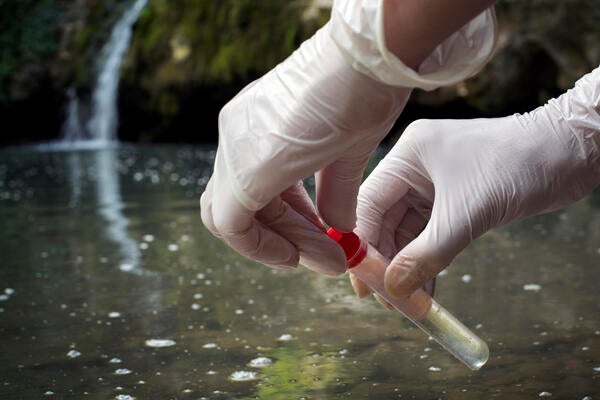
New discovery may be key to controlling chemical reactions
Unexpected resonance frequencies observed in reactions between two molecules

Unexpected resonance frequencies observed in reactions between two molecules
By Media RelationsA new study published today in Nature is changing our understanding of chemical reactions and overturning previous theoretical models by finding an unexpected resonance frequency during the reaction of two molecules.
Resonance is when one object vibrating at the same natural frequency as a second object forces that second object into vibrational motion.
This ground-breaking finding is the first time a resonance has been observed between two ultracold molecules and is a stepping-stone for researchers to learn about and control the molecules that comprise our universe.
“Resonances occur when vibrations at a specific frequency get preferentially amplified. For example, when a piano string gets hit by the hammer, it vibrates at a specific frequency based on the length and thickness, creating a musical note unique to that string,” said Dr. Alan Jamison from the Institute for Quantum Computing (IQC) and the Department of Physics and Astronomy at the University of Waterloo. “Similar resonances occur in atoms, where very specific frequencies of energy create stronger than expected responses in the chemical systems.”
Previously predicted to be an impossibility, Jamison and his collaborators from the Massachusetts Institute for Technology (MIT) were able to observe resonant frequencies in a chemical reaction between two ultracold molecules. By cooling down sodium-lithium molecules to near-absolute zero temperatures, the team could control the reactions at a quantum level. Without such control, the unusual resonance would never have been noticed.
“These seemingly simple systems still have a lot of surprising complexity hiding inside – Schrödinger wrote down his equation 100 years ago, but we still can’t solve it for a four-atom system,” said Jamison. “We’re pushing the frontier of understanding complex quantum dynamics.”
The research team probed the four-atom transition state with a magnetic field over a range of one million milligauss, a unit of measurement for the magnetic field strength. Within this search region, the resonant frequency found was only 25 milligauss wide.
“It was like finding a needle in a haystack,” said Dr. Wolfgang Ketterle, a professor at MIT. “When the magnetic field was tuned to this specific frequency, the chemical reaction was dramatically sped up.”
The discovery of these resonances holds promise for future applications in controlling chemical reactions. For example, an enhanced resonance may one day steer a chemical reaction or promote the formation of a desired product which would be less favourably made under non-resonance conditions, opening a new avenue and investigation tool for guiding molecular reactions.
The study, A Feshbach resonance in collisions between triplet ground state molecules, by Jamison, Ketterle, Juliana Park, Yu-Kun Lu and Dr. Timur Tscherbul, was published in Nature on February 1, 2023.

Read more
Waterloo research is leading the fight against an invasive plant threatening Ontario wetlands

Read more
Wastewater monitoring indicates early upward trends in COVID-19 and Influenza

Read more
The InnoHK Centre for Eye and Vision Research aims to bring eye and vision research to market through Waterloo-Hong Kong partnership
The University of Waterloo acknowledges that much of our work takes place on the traditional territory of the Neutral, Anishinaabeg, and Haudenosaunee peoples. Our main campus is situated on the Haldimand Tract, the land granted to the Six Nations that includes six miles on each side of the Grand River. Our active work toward reconciliation takes place across our campuses through research, learning, teaching, and community building, and is co-ordinated within the Office of Indigenous Relations.